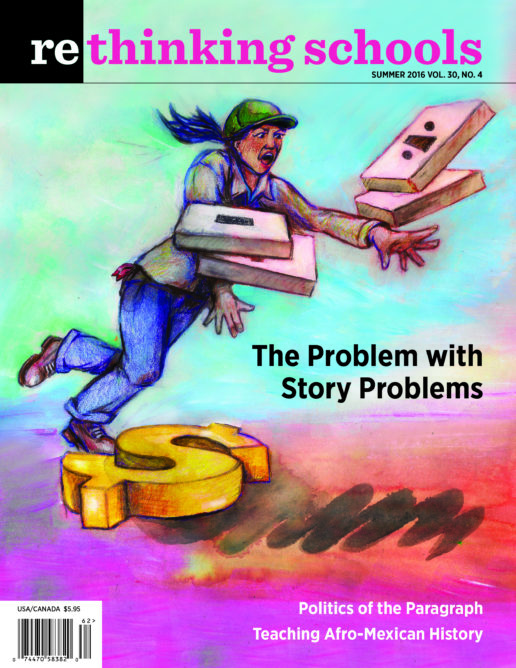Preview of Article:
“Kill the Indian, Kill the Deaf”
Teaching about the residential schools
Chiricahua Apache children on arrival at the Carlisle Indian Industrial School in 1886 (left) and the same children after they were forced to adopt “Boarding School Ways” (right).
As students in my middle school social studies classes examined American Indian and Deaf boarding schools at the turn of the 20th century and began to imagine themselves in similar situations, the reactions were visceral.
“I would refuse to go to school!”
“I think students and families would destroy the schools.”
At Metro Deaf School—a bilingual school in St. Paul, Minnesota, for Deaf students from ages 2 to 21—our primary language of instruction is American Sign Language (ASL). Alongside ASL, we teach written English as a second language. In addition, some students work on oral English in speech therapy.
Many Deaf students come from hearing families that don’t know or aren’t fluent in ASL. This means some students at our school don’t have access to the language their family uses at home (English, Hmong, Spanish, and Somali, among others), so their primary exposure to information and language happens at school in ASL and written English.
Developing Deaf Identity
As a white, hearing person who learned ASL as an additional language, my experiences with ASL and Deaf culture are different from those of my students. Knowing how important it is for Deaf students to connect to the broader Deaf world, I work to explicitly develop Deaf cultural consciousness. This ranges from knowing one’s right to have access to information, to feeling part of a larger Deaf culture. In Deaf studies lessons, ASL lessons, and my social studies lessons, students are immersed in the process of developing Deafhood—defining their place and identity as Deaf people within the intersections of multiple cultures, identities, and languages in their homes, communities, and school. I want my students to understand how these worlds fit together, and how they fit within these worlds.
As part of this process, I work throughout the year to honor the missing voices and history of Deaf, hard of hearing, and DeafBlind people. I decided it was important to teach the English-only and oralist policies at the turn of the 20th century and the impact this had on Deaf people.
In accordance with Minnesota middle school standards, I was already teaching local Native American history, focusing on the Anishinaabe and Dakota peoples. Because of the similarities in the way education was used to oppress Native Americans and Deaf people in the late 19th and early 20th century, I developed curriculum that helps students compare and contrast the goals and impact of Deaf and Native American schooling in this period.
Historical Photos as Text
I decided to start the unit with photographs. To do this, I selected images from the American Indian Boarding Schools collection at the Library of Congress website (see Resources). I chose photographs from the “Native Ways” and “Boarding School Ways” sections in the three categories suggested by the Library of Congress: Appearance, Homes, and Daily Life. Then I prepared a two-column graphic organizer.
“Remember how we talked about the experiences of different groups in Minnesota when white people started to come in large numbers in the 1860s?” I reminded my students. “Today we will be talking about life for Native Americans at the end of the 1800s.” I explained that we would be looking at education, an issue that affected many different Native American cultures, not just those in Minnesota. Then I distributed copies of the graphic organizer and the photographs.
I wanted students to pick a “Native Ways” image and a “Boarding School Ways” image to analyze for each category. We did the Appearance category together. I chose a pair of portraits of three Lakota boys from the Carlisle Indian Industrial School in Pennsylvania. In the “Native Ways” photo, two of the boys sit on the floor, one stands; the boys are wearing leggings, moccasins, and shirts; two have feathers in their hair, which hangs past their shoulders. In the “Boarding School Ways” photo, two of the boys are seated and one still stands. They are wearing military-style school uniforms: European-style pants, jackets with metal buttons, European-style shoes, and short haircuts.
“What differences do you notice between ‘Native Ways’ and ‘Boarding School Ways’?” I asked.
One student said, “At the school, the clothing is fancy.”
“What do you mean by fancy?”
“You know, normal.”
Another student, added, “The Indian clothes are dirty.”
I paused, wondering how to discuss cultural relativism. I also thought of the comparison to Deaf students, who see other people refer to hearing people as “normal,” implying that they are not. Not wanting to squash students’ reactions but also not wanting to let the issue go, I asked, “If your family was sending you away to school, do you think they would send you in your best clothes, or in dirty, old clothes?”
“Best clothing,” someone said. Others nodded in agreement.
“Do you think these students’ families sent them to school wearing dirty, old clothing, or their best clothing?” The students agreed it was likely these students had been wearing their best clothing when they got to the schools.

